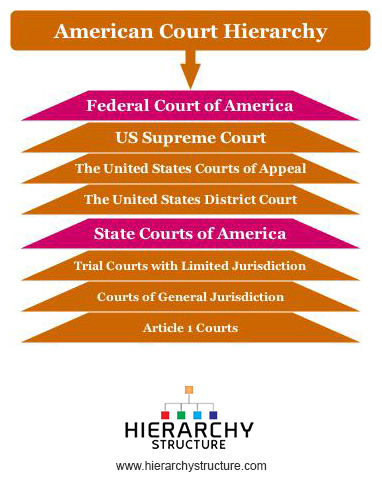The United States of America has many court systems including the Federal Court system and the 50 State systems. Every court system has its own functions, responsibilities, powers and procedures. Infact, each has its own structure or hierarchy as well.
This further contributes to the overall American Court Hierarchy. All courts are multi-tiered and most of the legal cases begin in a lower court and may or may not work its way up the ladder to a higher court. To understand the court hierarchyhttp://www.hierarchystructure.com/category/court-hierarchy/ system of America, you can read the following given information:
Federal Court of America
The Federal Court System is basically divided into districts and circuits. There is atleast one federal district in every state but some more populous states can have multiple districts as well. Mostly, the federal lawsuits start at the district level in a federal court. Most of these courses are civil and not criminal. The following is a hierarchy of the courts at Federal level:
US Supreme Court
The US Supreme Court is the highest level court in the American court system and its legal interpretations are the final word on the law. There are a total of 9 justices who work or sit in the Supreme Court are nominated by the President and are approved by the US Senate.
The United States Courts of Appeal
This is the intermediate federal appellate court system which operate under a system of mandatory review and this means that it must hear all appeals of right from the lower courts.
The United States District Court
These are the general federal trial courts which have jurisdiction to hear appeals from such tribunals.
State courts of America
State trial courts are the lowest tier in the state’s court system. Most states have two levels of trial courts which are the trial courts with limited jurisdiction and trial courts with specific jurisdiction. The following is the hierarchy of the States courts of America:
- Trial courts with limited jurisdiction-municipal courts, magistrate courts, county courts, justice of the peace courts, juvenile cases, minor criminal cases, traffic violation.
- Courts of general jurisdiction-circuit courts, district courts, superior courts, court of common pleas,
- There are a number of Article 1 courts which have appellate jurisdiction over certain specific matters and these include the Court of Appeals for Veterans Claim, Court of Appeals for the Armed Forces, District of Columbia Court of Appeals, Bankruptcy Courts, Immigration courts, court of Federal Claims and Tax Court.
Know about US Police Hierarchy.

